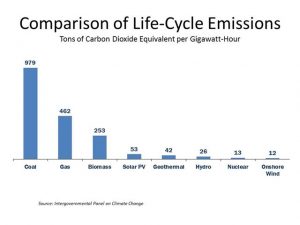The main theme of our discussions so far has been to lessen people’s irrational fear and misconceptions about nuclear power (NP), which is often fuelled by misinformation. We have learned that we live in the sea of all kinds of radiation, and mostly (about 80%) is derived from natural sources, with only about 20% from man-made sources, which is largely dominated by radiation used for several indispensable purposes in hospitals. It has been stressed that nuclear reactors are so robustly built with diverse measures and redundant barriers that their annual share in background radiation is negligible. Hence, the risk of dying from NP is very remote.
Over the next few sessions, our focus will shift to unpackaging the fact that nuclear energy is the most concentrated energy source out of all energy sources available for power production. By the terms of the Paris Climate Change Agreement, nuclear power (NP), hydro power (HP), wind power (WP), and solar power (SP), which are low-carbon energy sources, are expected to produce enough electricity to replace the energy needs from fossil fuels in all the economic sectors in the anticipated future without fossil fuels.
It needs to be said that due to some socio-political reasons or perhaps societal preference stoked by irrational fear of radiation, only WP and SP, the most diluted energy sources for power generation, are more often promoted.
The practical data we shall use for our discussions will come from high growing economies in three distinctly geographical areas, namely the USA, the EU and China.
Let’s start by reviewing two graphs which stress the safety of NP.
Figure 1.

The First Graph on ‘Tons of Carbon Dioxide Equivalent per Gigawatt-hour’, (Fig1) from the studies of IPCC, is self-explanatory, and it compares very well with the second External Cost studies of the EU, (depicted in Fig2). It is interesting to add that the results of the first External Studies of the EU, given in a table and published in 2001, showed that even in temperate areas, NP is more environmentally friendly than hydropower.
Figure 2

The Second Graph is on ‘Natural and Manmade Exposure to Radioactivity’ (Fig3) in the USA, a country with the largest fleet of power reactors. Yet, living close to a power reactor in the USA, one’s annual dose of radiation from NP is only 1mrem, as compared to 228 and 80mrem from radon and cosmic rays respectively. Take note of 29mrem in human body, as well as 10 and 42mrem one receives per procedure of X-ray and mammogram respectively.
Figure 3.

The Energy Intensity in Nuclear Energy
As stated previously, nuclear energy is the most concentrated energy source for power generation, while WP and SP are the most diluted source. Since nuclear is highly concentrated, the size of a given amount of fuel, will be relatively very small, and that can be deduced from the famous equation of Albert Einstein, E=mc2 in which ‘m’ stands for the mass of fuel, while ‘c’ is the speed of light.
To put the energy intensity of NP in more practical terms, let’s compare fuel requirements for a 1000MWe power plant based on coal and nuclear fuel. A coal power plant requires daily about 9000 tons of coal, while a nuclear power requires only 3kg of uranium-235 or U-235 each day. However, in practical terms, the concentration of U-235 isotopes in fresh or new nuclear fuel for power reactors is less than 5%. An operating 1000MW reactor requires about 30 tons of about 3.5% enriched nuclear fuel once every 18 months to replace one-third of the core fuel, when the reactor is routinely stopped for maintenance. The fuel discharged from the reactor is the batch which has been in the core for three cycles or about 54 months.
We learned during our earlier discussions on used nuclear fuel that nuclear fuel that has been used in the core for about 4-5 years and discharged as spent fuel or used fuel, contains about 95% of the original fuel. After the hazardous short-lived fission products have decayed away over a period of approximately 12 years, about 1% of the long-lived radioactive products hinder the deployment of used nuclear used fuel. Therefore, used nuclear fuel is reprocessed before it is used in current power reactors.
There are now several innovative modular reactors, which can be fuelled with used fuel, natural and depleted uranium. Most importantly, countries with large inventories of used nuclear fuel will have enough nuclear fuel at hand to generate their power needs for a century or more.
The Major Limitations of Wind and Solar Power
The worst limitations for WP and SP include their variability and intermittency. In fact, out of all practical energy sources for power generation we have discussed, only WP and SP are known to be variable and intermittent. WP does not produce electricity when wind is not blowing, and SP does not produce electricity when there is no sun, or when the sun is covered.
Hence WP and SP are intermittent energy sources, which in energy-sector, implies that they do not produce reliable or dependable electricity for the grid. A better way to utilize WP and SP generated electricity is to store it in batteries and use later, when needed, in niche domestic purposes.
Many research institutions and industries have spent a number of decades strenuously exploring a more appropriate device to store electricity in large quantities for commercial purposes. The envisaged storage should be more efficient and affordable than our current batteries.
It can be deduced from above that, due to the intermittency of WP and SP, they have much less available time to produce electricity. Let’s note that SP may generate electricity in only 10 out of 24 hours in a day. That explains why, SP has the lowest capacity factor (CF), which is also known as load factor in the energy sector, which we shall explore in more detail in the next episode.
The stark irony, however, is that, without the ideal energy storage, WP and SP, which have been the fastest growing clean energy sources for power production over the past 2 decades, usually have to rely on the polluting coal as their backup! It is evident that that will not be able to wean ourselves from coal and transition to a low carbon economy as envisaged by the Paris Climate Change Agreement unless we have a serious discussion about all the energy sources and the role of NP in the energy mix.










